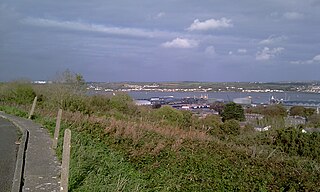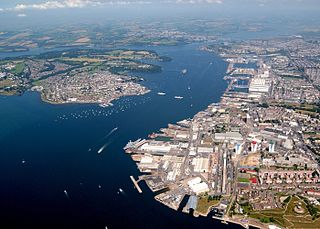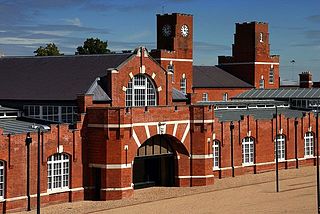Related Research Articles

The Navy Board was the commission responsible for the day-to-day civil administration of the Royal Navy between 1546 and 1832. The board was headquartered within the Navy Office.

Royal Navy Dockyards were state-owned harbour facilities where ships of the Royal Navy were built, based, repaired and refitted. Until the mid-19th century the Royal Dockyards were the largest industrial complexes in Britain.

The Commander-in-Chief, The Nore, was an operational commander of the Royal Navy. His subordinate units, establishments, and staff were sometimes informally known as the Nore Station or Nore Command. The Nore is a sandbank at the mouth of the Thames Estuary and River Medway. In due course the Commander-in-Chief became responsible for sub-commands at Chatham, London, Sheerness, Harwich and the Humber.

Pembroke Dockyard, originally called Pater Yard, is a former Royal Navy Dockyard in Pembroke Dock, Pembrokeshire, Wales.

His Majesty's Naval Base, Devonport is one of three operating bases in the United Kingdom for the Royal Navy and is the sole nuclear repair and refuelling facility for the Royal Navy. The largest naval base in Western Europe, HMNB Devonport is located in Devonport, in the west of the city of Plymouth, England.
Port admiral is an honorary rank in the United States Navy, and a former appointment in the British Royal Navy.
Admiral Henry Eden was a senior British Royal Navy officer who went on to be Second Naval Lord.

The Commander-in-Chief, Portsmouth, was a senior commander of the Royal Navy for hundreds of years. The commanders-in-chief were based at premises in High Street, Portsmouth from the 1790s until the end of Sir Thomas Williams's tenure, his successor, Sir Philip Durham, being the first to move into Admiralty House at the Royal Navy Dockyard, where subsequent holders of the office were based until 1969. Prior to World War I the officer holder was sometimes referred to in official dispatches as the Commander-in-Chief, Spithead.

The Commander-in-Chief, Plymouth, was a senior commander of the Royal Navy for hundreds of years. Plymouth Command was a name given to the units, establishments, and staff operating under the admiral's command. Between 1845 and 1896, this office was renamed Commander-in-Chief, Devonport. The Commanders-in-Chief were based in what is now Hamoaze House, Devonport, Plymouth, from 1809 to 1934 and then at Admiralty House, Mount Wise, Devonport, from 1934 until 1996.
Rear Admiral William Codrington CB was a Royal Navy officer who went on to be Junior Naval Lord.
Edward Holl was an architect to the Navy Board, then later Surveyor of Buildings to the Board of Admiralty of the Royal Navy. His father is presumed to be Edward Holl, a stonemason from Beccles in Suffolk, who died in January 1816.

During the early 17th century, England's relative naval power deteriorated; in the course of the rest of the 17th century, the office of the Admiralty and Marine Affairs steered the Navy's transition from a semi-amateur Navy Royal fighting in conjunction with private vessels into a fully professional institution, a Royal Navy. Its financial provisions were gradually regularised, it came to rely on dedicated warships only, and it developed a professional officer corps with a defined career structure, superseding an earlier mix of sailors and socially prominent former soldiers.

The Glorious Revolution of 1688 rearranged the political map of Europe, and led to a series of wars with France that lasted well over a century. This was the classic age of sail; while the ships themselves evolved in only minor ways, technique and tactics were honed to a high degree, and the battles of the Napoleonic Wars entailed feats that would have been impossible for the fleets of the 17th century. Because of parliamentary opposition, James II fled the country. The landing of William III and the Glorious Revolution itself was a gigantic effort involving 100 warships and 400 transports carrying 11,000 infantry and 4,000 horses. It was not opposed by the English or Scottish fleets.

The Admiral-superintendent, Portsmouth was the Royal Navy officer in command of the Naval Dockyard. Portsmouth from 1832 to 1971; prior to this date a resident Commissioner of the Navy Board had had oversight of the yard, since 1649. In May 1971 command responsibility for naval staff in the dockyard was merged into the wider local command structure, initially under the dual designation of Flag Officer, Portsmouth and Admiral Superintendent, Portsmouth but in July 1971 was again renamed Flag Officer Spithead and Port Admiral Portsmouth after a couple of months. These joint titles was used until 1975, and despite the name change the command still covered the same geographic area and operational responsibilities until 1996 when its ceased to exist as a separate command appointment and its responsibilities were assumed by the staff of Flag Officer First Flotilla.

The Naval Ordnance Stores Department, was a former department of the Admiralty responsible for the management of naval ordnance storage facilities and depots of the Royal Navy the department was managed by a Superintendent of Stores supported by various deputy and assistant superintendents's it existed from 1891 to 1918 when it was replaced by the Armament Supply Department.

The Department of the Director of Dockyards, also known as the Dockyard Branch and later as the Dockyards and Fleet Maintenance Department, was the British Admiralty department responsible from 1872 to 1964 for civil administration of dockyards, the building of ships, the maintenance and repair of ships at dockyards and factories, and the supervision of all civil dockyard personnel.

The Victualling Department originally known as the Department of the Comptroller of Victualling and Transport Services or the Victualling Office, also known as the Department of the Director of Victualling was the British Admiralty department responsible for civil administration of Victualling Yards and the storing and supply of Naval Victuals for the Royal Navy from 1832 to 1964.

The Royal Naval Barracks, Chatham, also known as HMSPembroke, was a UK naval barracks that was built between the Victorian Steam Yard and Brompton Barracks from 1897 to 1902. It was built on the site of a prison built in 1853 to house over 1,000 convicts, with the intention that they would be used to build the Dockyard extension.

The Flag Officer Plymouth was a senior Royal Navy appointment first established in July 1969. The office holder was responsible for the administration of the faciliites of the two major Royal Navy at Plymouth and Portsmouth. The appointment continued until 1996 when it was abolished.
References
- ↑ "Royal Naval dockyard staff". nationalarchives.gov.uk. The National Archives, UK, 2016. Retrieved 3 November 2016.
- ↑ Carradice, Phil (2013). The Ships of Pembroke Dockyard. Stroud, Gloucs.: Amberley.
- ↑ "Royal Naval dockyard staff". nationalarchives.gov.uk. The National Archives, UK, 2016. Retrieved 3 November 2016.
- ↑ Stewart, William (2009). Admirals of the World: A Biographical Dictionary, 1500 to the Present. Jefferson, N.C.: McFarland. p. 47. ISBN 9780786438099.
- ↑ "Portsmouth Royal Dockyard Historical Trust".
- ↑ "House of Commons 15 October 1969". Parliamentary Debates (Hansard) . 15 October 1969.
- ↑ "House of Commons 27 July 1971". Parliamentary Debates (Hansard) . 27 July 1971.
- ↑ "Naval Biographical Database". navylist.org. Navylist.org, 2004. Retrieved 4 November 2016.
- ↑ "Naval Biographical Database". navylist.org. Navylist.org, 2004. Retrieved 4 November 2016.
- ↑ "Naval Biographical Database". navylist.org. Navylist.org, 2004. Retrieved 4 November 2016.
- ↑ Harley, Simon; Lovell, Tony. "Admirals Superintendent of Portsmouth Dockyard". The Dreadnought Project, 26 September 2016. Retrieved 3 November 2016.
- ↑ "1832 - First Admiral Superintendent Appointed". portsmouthdockyard.org.uk/. Portsmouth Royal Dockyard Historical Trust, 2015. Retrieved 4 November 2016.
- ↑ "Naval Biographical Database". navylist.org. Navylist.org, 2004. Retrieved 4 November 2016.
- ↑ Mayne, Richard O. (2011). Betrayed: Scandal, Politics, and Canadian Naval Leadership. UBC Press. p. 117. ISBN 9780774840132.
- ↑ The Navy List 1834. Originally H.M. Stationery Office, Digitized by University of Michigan. 26 Sep 2006. p. 137.